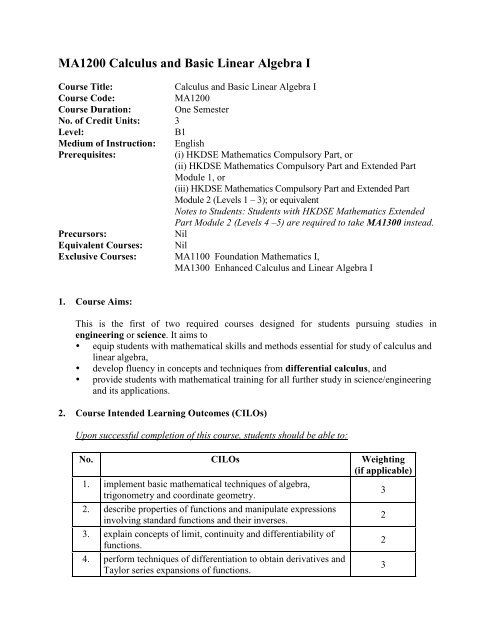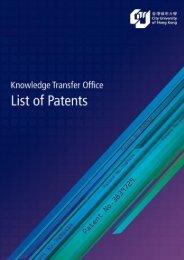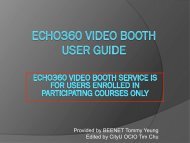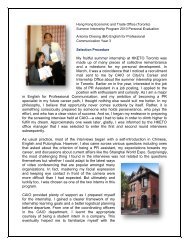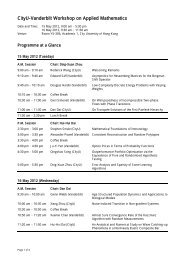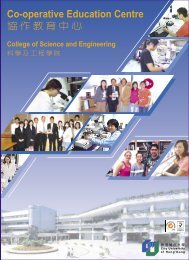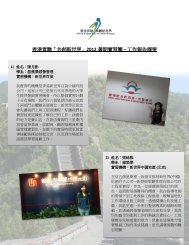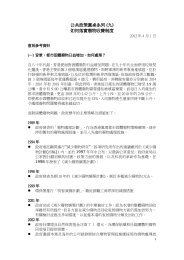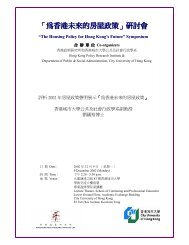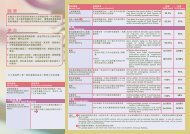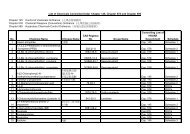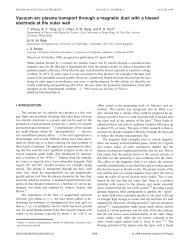MA1200 Calculus and Basic Linear Algebra I
MA1200 Calculus and Basic Linear Algebra I
MA1200 Calculus and Basic Linear Algebra I
You also want an ePaper? Increase the reach of your titles
YUMPU automatically turns print PDFs into web optimized ePapers that Google loves.
<strong>MA1200</strong> <strong>Calculus</strong> <strong>and</strong> <strong>Basic</strong> <strong>Linear</strong> <strong>Algebra</strong> I<br />
Course Title: <strong>Calculus</strong> <strong>and</strong> <strong>Basic</strong> <strong>Linear</strong> <strong>Algebra</strong> I<br />
Course Code: <strong>MA1200</strong><br />
Course Duration: One Semester<br />
No. of Credit Units: 3<br />
Level: B1<br />
Medium of Instruction: English<br />
Prerequisites: (i) HKDSE Mathematics Compulsory Part, or<br />
(ii) HKDSE Mathematics Compulsory Part <strong>and</strong> Extended Part<br />
Module 1, or<br />
(iii) HKDSE Mathematics Compulsory Part <strong>and</strong> Extended Part<br />
Module 2 (Levels 1 – 3); or equivalent<br />
Notes to Students: Students with HKDSE Mathematics Extended<br />
Part Module 2 (Levels 4 –5) are required to take MA1300 instead.<br />
Precursors: Nil<br />
Equivalent Courses: Nil<br />
Exclusive Courses: MA1100 Foundation Mathematics I,<br />
MA1300 Enhanced <strong>Calculus</strong> <strong>and</strong> <strong>Linear</strong> <strong>Algebra</strong> I<br />
1. Course Aims:<br />
This is the first of two required courses designed for students pursuing studies in<br />
engineering or science. It aims to<br />
equip students with mathematical skills <strong>and</strong> methods essential for study of calculus <strong>and</strong><br />
linear algebra,<br />
develop fluency in concepts <strong>and</strong> techniques from differential calculus, <strong>and</strong><br />
provide students with mathematical training for all further study in science/engineering<br />
<strong>and</strong> its applications.<br />
2. Course Intended Learning Outcomes (CILOs)<br />
Upon successful completion of this course, students should be able to:<br />
No. CILOs Weighting<br />
(if applicable)<br />
1. implement basic mathematical techniques of algebra,<br />
trigonometry <strong>and</strong> coordinate geometry.<br />
3<br />
2. describe properties of functions <strong>and</strong> manipulate expressions<br />
involving st<strong>and</strong>ard functions <strong>and</strong> their inverses.<br />
2<br />
3. explain concepts of limit, continuity <strong>and</strong> differentiability of<br />
functions.<br />
2<br />
4. perform techniques of differentiation to obtain derivatives <strong>and</strong><br />
Taylor series expansions of functions.<br />
3
No. CILOs Weighting<br />
(if applicable)<br />
5. apply methods of differential calculus to dynamical <strong>and</strong><br />
optimization problems as well as applications in science <strong>and</strong><br />
engineering.<br />
3<br />
3. Teaching <strong>and</strong> Learning Activities (TLAs)<br />
Students are assigned to lecture sessions according to mathematical background <strong>and</strong>/or<br />
results in HKDSE mathematics.<br />
Students of Section C <strong>and</strong> D benefit from extra tuition hours.<br />
Compulsory Part<br />
HKDSE Mathematics<br />
Module 1 Module 2<br />
Section<br />
(Levels 2 – 3) A<br />
<br />
(Levels 3 – 5)<br />
U or (Level 1)<br />
B<br />
<br />
<br />
(Levels 1 – 2)<br />
U<br />
C<br />
D<br />
Note: = passed U = unclassified<br />
TLAs ILO No. Hours/week<br />
Learning through teaching is primarily based<br />
on lectures.<br />
Learning through tutorials is primarily based<br />
on interactive problem solving allowing instant<br />
feedback.<br />
Learning through take-home assignments<br />
helps students implement basic concepts of<br />
functions <strong>and</strong> techniques of differential<br />
calculus, as well as apply knowledge of which<br />
to problems in science <strong>and</strong> engineering.<br />
1 – 5<br />
1<br />
2<br />
3<br />
4<br />
5<br />
39 hours in total<br />
(A/B);<br />
46 hours in total<br />
(C/D)<br />
3 hours in total (A/B);<br />
4 hours in total (C/D)<br />
2 hours in total (A/B);<br />
3 hours in total (C/D)<br />
2 hours in total (A/B);<br />
3 hours in total (C/D)<br />
3 hours in total (A/B);<br />
5 hours in total (C/D)<br />
3 hours in total (A/B);<br />
4 hours in total (C/D)<br />
1 – 5 after class
TLAs<br />
Learning through online examples for<br />
ILO No. Hours/week<br />
applications helps students apply methods of<br />
differential calculus to practical problems in<br />
science <strong>and</strong> engineering.<br />
5 after class<br />
Learning activities in Math Help Centre<br />
provides students extra assistance in study.<br />
4. Assessment Tasks/Activities<br />
(designed to assess how well the students achieve the CILOs)<br />
1 – 5<br />
30% Coursework<br />
70% Examination (Duration: 2 hours, at the end of the semester)<br />
after-class,<br />
depending on need<br />
For a student to pass the course, at least 30% of the maximum mark for the examination<br />
must be obtained.<br />
Assessment<br />
Tasks/Activitie<br />
s<br />
ILO No.<br />
Weighting<br />
(if applicable)<br />
Quizzes/Test(s) 1 – 5 15 – 30%<br />
H<strong>and</strong>-in<br />
assignment(s)<br />
1 – 5 0 – 15%<br />
Examination 1 – 5 70%<br />
Remarks<br />
Questions are designed to see how<br />
well students have learned basic<br />
mathematical methods, concepts of<br />
functions, limits <strong>and</strong> continuity, as<br />
well as techniques <strong>and</strong> applications of<br />
differential calculus. These assessment<br />
tasks monitor students’ progress <strong>and</strong><br />
reveal gaps in knowledge.<br />
These are skills based assessment to<br />
see whether students are familiar with<br />
essential mathematical methods,<br />
properties of functions, techniques <strong>and</strong><br />
applications of differential calculus.<br />
Examination questions are designed to<br />
see how far students have achieved<br />
their intended learning outcomes.<br />
Questions will primarily be skills<br />
based to assess the extent to which<br />
students have mastered methods of the<br />
course <strong>and</strong> synthesized mathematical<br />
knowledge in practical applications.
5. Grading of Student Achievement: Refer to Grading of Courses in the Academic Regulations (Attachment)<br />
<strong>and</strong> to the Explanatory Notes.<br />
A−, A, A+<br />
To achieve a grade of A, a student should<br />
have complete, or close to complete, mastery of all of the core components (CILOs 1 –<br />
4),<br />
<strong>and</strong> have demonstrated high levels of fluency in mathematical writing <strong>and</strong> synthesis of<br />
core components, as evidenced by the successful use of mathematical techniques in<br />
applications (CILO 5).<br />
B−, B, B+<br />
To achieve a grade of B, a student should<br />
have good or very good mastery of all of the core components (CILOs 1 – 4),<br />
<strong>and</strong> have demonstrated good to very good levels of fluency in mathematical writing <strong>and</strong><br />
synthesis of core components in applications (CILO 5).<br />
C−, C, C+<br />
To achieve a grade of C, a student should have good working knowledge<br />
of all of the core components of the course (CILOs 1 – 4);<br />
or, alternatively, of most of the core components of the course together with some<br />
demonstrated ability to synthesise them in applications (CILO 5).<br />
D<br />
To achieve a grade of D, a student should have some working knowledge<br />
of most of the core components of the course (CILOs 1 – 4);<br />
or, alternatively, of some of the core components of the course together with some<br />
demonstrated ability to synthesise them in at least an application (CILO 5).<br />
Keyword Syllabus:<br />
A) Polynomials; Mathematical induction; Binomial theorem<br />
B) Coordinate geometry <strong>and</strong> conic sections; <strong>Basic</strong> trigonometry<br />
C) Functions <strong>and</strong> inverses; Limits, continuity <strong>and</strong> differentiability<br />
D) Techniques of differentiation, implicit, logarithmic <strong>and</strong> parametric differentiation;<br />
Successive differentiation<br />
E) Applications of differentiation: rate of change, local extrema, optimization problems,<br />
Taylor series, l’Hôpital rule
Recommended Reading:<br />
For further detailed information, please refer<br />
to http://www6.cityu.edu.hk/ma/teaching/teaching_readings.asp<br />
Online Resources:<br />
Nil


